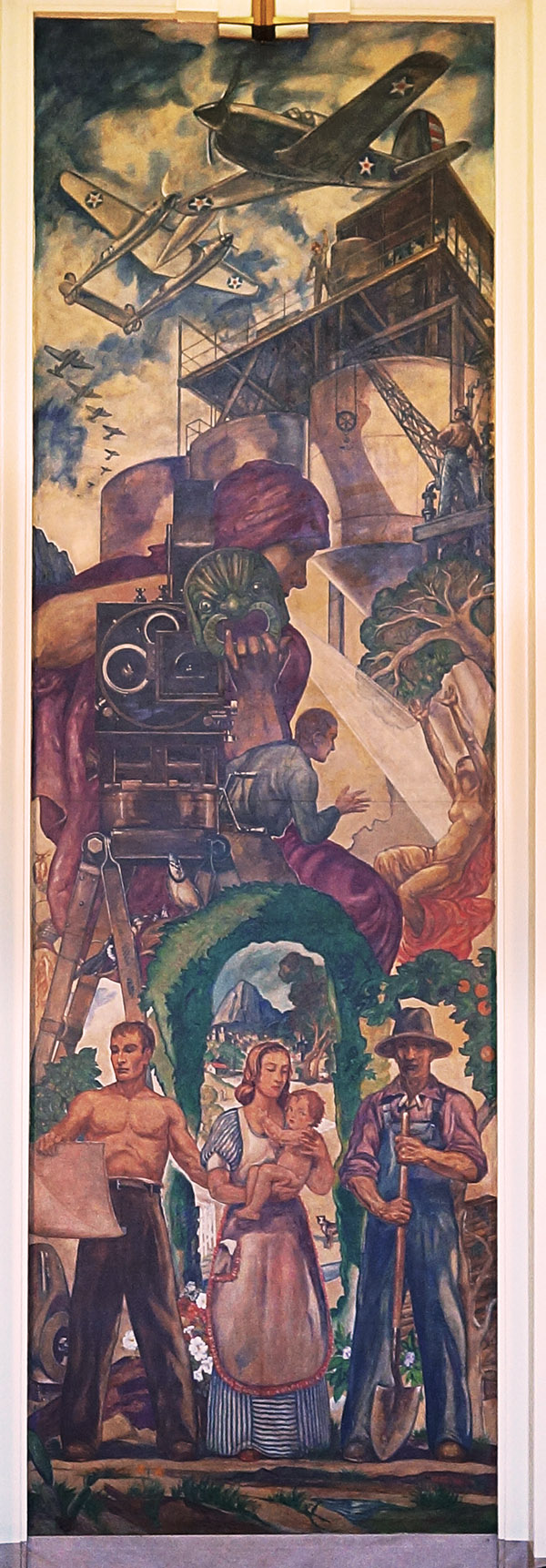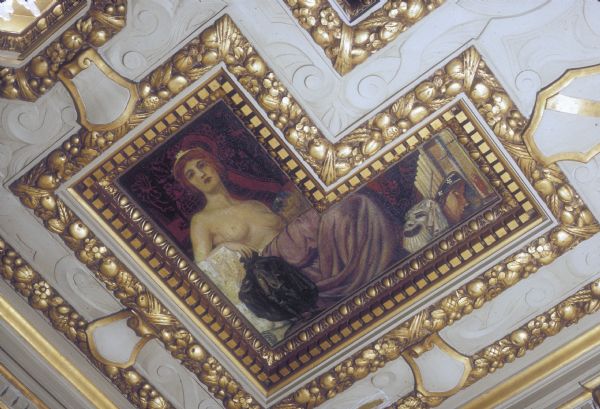Burbank City Hall - Burbank Industry

- Allegory and History
- Cinematic Influences
- Source/Citations
Ballin chose to showcase the workers in the various industries that had contributed to Burbank's development in this panel: farmers at the bottom, a director and actress performing in the middle, and industrial workers at an aviation plant at the top. Each is depicted with the tools of their productive work and/or the fruits of their labor and designed to represent "the economic and social base of the community."1 Notably absent from this panel, however, are the indigenous and Mexican people who occupied the area in the years before Dr. Burbank purchased the land, as well as the Mexican, African and Asian Americans workers who contributed to the city's industrial development. Instead of offering a more complete history of Burbank from its prehistoric origins to "modern times" as he did for the city of Los Angeles in the Title Guarantee Building, Ballin presents a more narrow story of Burbank's three decades as an incorporated city, and a more romantic portrayal of the progress of "Burbank Industry" during that time.
The only allegorical figure in the piece is the outsized woman enrobed in red in the center of the piece. She is likely symbolic of the cinematic arts or perhaps the arts more broadly, as she holds a mask to symbolize drama and theater, thereby echoing Ballin's depiction of "the Spirit of the Arts" in the ceiling of the Executive Chamber at the Wisconsin State Capitol. The size and prominence of the figure - especially when compared to the industrial workers and ultra-modern planes at the top - suggests that Ballin saw Burbank as a capital for cultural production, rather than war production, even though its aviation industry was a far bigger part of the city's economy at the time.
 "The Spirit of the Arts," 1913 |
Ballin's filmmaking techniques are on clear display in this mural. In his set designs, he worked to create “broken planes, with receding and advancing surfaces, each receiving a different amount of light” that would give the shots dimension and depth.2 Here, he similarly created multiple, fragmented planes by positioning Burbank's "industries" at different depths and painting his figures on different scales to give the mural a chronological arch. As a result, the mural appears as a montage, moving with an upward thrust that conveys Burbank’s progress and development over the course of its three decades as an incorporated city. The viewer's eyes are drawn upward to see the other decorative elements in the central tower - Ballin using the same technique as he had with the murals at Griffith Observatory.
Details on the mural courtesy of the City of Burbank. Photo by David Wu.
1. Description as appears in the Souvenir Program from the 50th Anniversary Celebration of Burbank City Hall Feb. 12th, 1993.
2. Quoted in Ovnick, Merry, “The Mark of Zorro: Silent Film’s Impact on 1920s Architecture in Los Angeles,” California History vol. 86, no 1 (2008): 28-59, esp. 29, 35-36, 40.
| Previous page on path | Burbank City Hall, page 4 of 5 | Next page on path |

Discussion of "Burbank City Hall - Burbank Industry"
Add your voice to this discussion.
Checking your signed in status ...